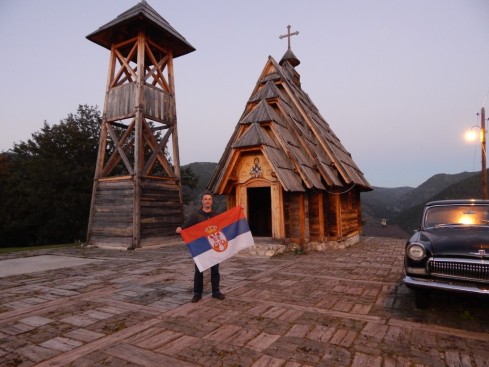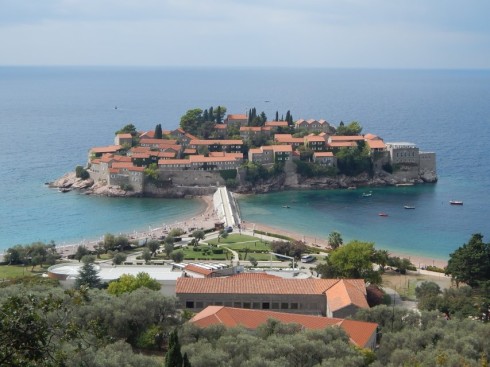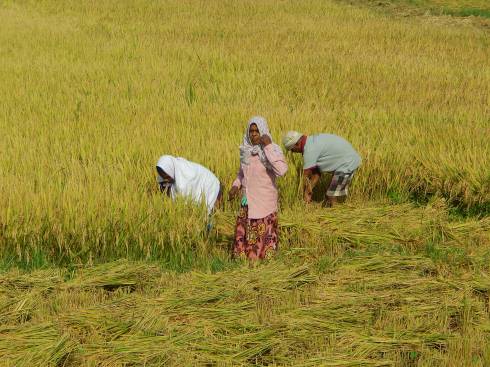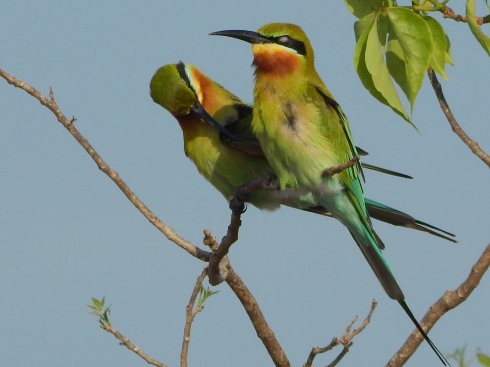Entering Serbia on the morning of 26th September, I didn’t immediately notice a huge difference from Montenegro. We did stop at a money exchange counter in the nearest town, after requiring a 2 mile detour because of roadworks. We’ll see how far €50 goes for two nights!
The first stop was at another monastery – this one was called Mileseva – named after Sveti Sava (Saint Sava) who was a famous chap from around here. It featured some stone swan plant pots, large flags, an informative nun (if you could understand Serbian), and a retouched “White Angel” fresco, depicting an angel visiting the grave of Christ, and a modern art monument of it outside. The frescoes were in two layers – from the 13th and 16th centuries. King Vladislav built the place and therefore had his grave there. Some of the earlier roof space was used to print illicit manuscripts. Old, small but full of history.
The other 6 nuns, all aged between 17 and 30 were unfortunately busy cleaning and gardening (I don’t think they were trusted with the tourists – or was it the other way around?) The older nun gave a special tour of the treasury to those that were originally interested. After several broken inscribed stones, reconstructed pottery etc… we got to the books – one gifted by Catherine the Great (of Russia), one of the earliest written books and one of the earliest printed ones as well. All well protected behind glass cases. Also here was a golden and jewel encrusted staff like object that symbolised the independence of the Serbian Orthodox church. This was granted before the Russian Orthodox church, although the Serbians started later. (They are very proud of this!)

Some very scenic picnic tables allowed us to enjoy the delights of the bakery produce we’d guessed at in the morning. I ended with a sausage/salami and cheese flaky pastry (rather dry), and a somewhat more flat-but-moist cheese and ham pastry. Thankfully I’d also bought the largest moist chocolate cake that fitted in a container.


Driving on, we stopped at Zlatarsko Jezero (Gold Lake) for a toilet break and coffee. Most found the interior of the restaurant unpleasant due to the smokers. Confrontation was mostly avoided, whilst the asthma sufferers had to content themselves with the fantastic scenery.
Over an hour later, we arrived at the open air museum that was the Old Village of Sirogojno. After negotiating the newly installed gates, we arrived in the middle ages and were delighted to be informed that we were to be staying in some drafty wooden houses for the night. I ended up in a 5 bed affair. It had Serbian TV (not to be recommended), a kitchen and dining room, and an open fire that looked like it hadn’t been touched since Roman times.

We had a brief introduction to the village from the local guide and then had a chance to explore it ourselves. The dead/sleeping dog next to the church was a particular highlight. The cooperage, diary (dairy), fruit drying store, blacksmith workshop, pigsty, barn and stable were all separate buildings to the actual houses. Families all lived together with up to 20 members in the one commune. There was also a gift shop. Apparently not every visitor HAS to stay the night.

As the temperature sank to near freezing, we gathered for the evening meal in the warmest building of the village and attempted to understand the menu. It wasn’t that it wasn’t in English, it was more that it consisted of things like “Wedding Sauerkraut”, “Buckwheat pie”, “Kajmak, a serving” and “Moussaka with curled dock and nettle”. I suddenly felt full.
I had to settle on the sauerkraut, which was a bowl of boiled cabbage with a few shreds of salty meat on top – still on the bone to make it look bigger. Thankfully, there was alcohol to help you forget the whole experience. I settled for the “hot domestic plum brandy”, which burned away any cabbage that had accidentally become lodged in my gullet.
The blankets on the bed were well used, and all of the survivors of the bitterly cold night assembled for breakfast in the warm room. The less said about that the better. Just never order corn bread! Following this, some local knitters came to demonstrate their craft (I think they also wanted the warmth) and some of us had a better go than others at knitting. Mostly, it consisted of them demonstrating, a man attempting, a laugh, an unpicking and repeat. Fascinatingly, they didn’t mostly use local wool – importing it from Iceland (the country, not the supermarket).
Packing up, we also stopped off at the knitters museum, where fashions from the 1970’s were on display and could apparently still be bought. Most avoided the dilemna, although a red hat was purchased. Apparently, there is a saying about red hats and (lack of) undergarments. #NotChecking. But seriously, the sweaters were winning world fashion awards in the 1980s, much in the same way that Fair Isles jumpers still do today. At their peak, 1000 were being produced every month (about 3 per knitter day).

Back on the road, we stopped at a petrol station and I tried a local Slovenia carbonated drink – Cockta. A bit like coke, but with a distinctly herbal taste.
We arrived at Mokra Gora (wet mountain) for a trip on the historic narrow gauge railway know as Sangan Eight. It used to link Sarajevo with Belgrade, but was closed in 1974. It was reopened in 1999 and weaves through 22 tunnels over 15km. The stations (Sargan and Mokra Gora) are only actually 3.5km apart as the crow flies, but it goes in a figure of 8 loop to help climb the hill. We like to think of it as an ideal Agatha Christie murder mystery train. Every time you try to take a scenic photo, a tunnel appears! We did manage to procure a whole carriage for three of us though.
On the return journey the train stopped at Jatape, where there were opportunities to climb steps, drink coffee, buy ice cream and take photos of cats and dogs. After accomplishing most of that, we also had a bried scenic stop at the “Love Stone”, which due to some local legend will give you what your heart desires if you touch it, stand on it or kick it (all of the above witnessed). The local school party were also in attendance.

Overnight accommodation was just around the corner in Kustendorf. This distinctive mountain village was built by the international film director, Emir Kusturica, for his movie “Life is a Miracle”. Nope. Me neither. Everything here is constructed from wood and he wanted to recreate a traditional Serbian village, with the exception that all the streets are named after famous film directors. Now days, it is his home, a hotel and also home to an annual international film and music festival. The Stanly Kubric Theatre didn’t appear to be showing anything, thankfully. I did spot a pastry shop, a gift shop, a couple of restaurants and some old cars dotted about the non-wheelchair accessible cobbled steps. Of course, I was staying in the chalet at the bottom of the hill. Although the whole group argued about who was the furthest away from the top of the hill. In the morning we had the option of porters to carry the bags back up the hill!



My very green room, had a children’s playground outside, which we were instructed not to use after midnight. Having previously bought a flag, I thought it would be appropriate to have my photo taken with it. Unfortunately, one of the local staffies took a playful liking to it and to me, and I required some help to disentangle ourselves, whilst other members of the group mostly managed to hold off with their uproarious laughter.

Bee Spit Rakija
Evening meal was substantially nice than the previous evening, with noodle soup and meatballs in tomato sauce with mashed potato. All followed up with bee spit rakija, served in a traditional test tube glass.

Heading for breakfast the next morning, the staffie was on his best behaviour as we skipped the queue and sneaked into the breakfast room via the back door. No rush required though as various deep fried dough balls and the umbiquitous chicken sausage was all that was on offer. Wouldn’t recommend having mayonaisse on your muesli as some did. We avoided the “Damned Yard”, the swimming pool and the wellness centre.
Depart after the long trek up the hill with my bags, we headed for the next adventure in Bosnia …

Thoughts on Serbia …
I only saw a very small corner in the south west, but it was certainly scenic. Not so mountainous as Montenegro, but nice hills. The people are far more brusque, but that may be due to language issues. Certainly, the feeling of superiority of the Serbian Slavs is very apparent. Not the nicest food I’ve ever had, but then it was all part of the experience. Avoid the dogs!














































































































Recent Comments